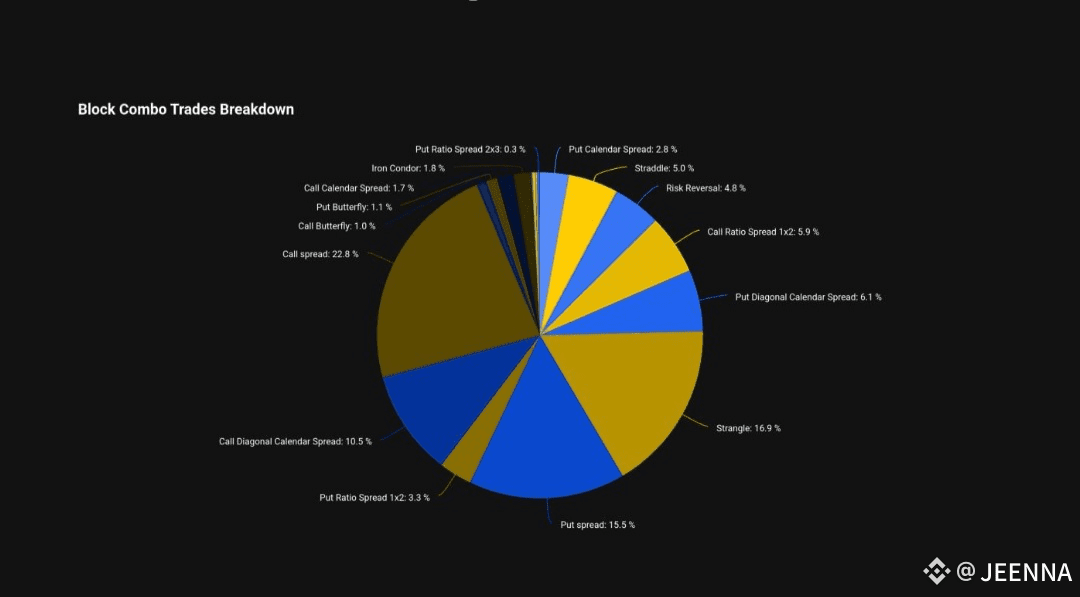The crypto options market is quietly revealing a deeper divide among big players as uncertainty grips digital assets. While Bitcoin traders appear to be bracing for major moves in either direction, some XRP whales are taking the opposite side of that bet—selling volatility and wagering that the storm has already passed. The divergence highlights a market at a crossroads, where conviction has faded but opportunity still lurks in the spaces between calm and chaos.
According to recent block trade data from Deribit, the world’s largest crypto options exchange, large Bitcoin investors have been loading up on non-directional volatility strategies. Over the past week alone, strangles accounted for nearly 17% of Bitcoin option blocks, while straddles made up another 5%. Combined, that means more than one-fifth of all block flows are tied to strategies designed to profit from big moves—regardless of direction. It’s a striking sign that institutions are positioning for action without committing to a specific bias.

Deribit CEO Luuk Strijers put it plainly: the market is struggling to find its footing. Traders expect volatility, but they’re split on what kind. “This suggests a market grappling with uncertainty, where traders anticipate significant price moves but remain unsure about the direction,” he told CoinDesk. In other words, Bitcoin’s rangebound behavior may be masking a buildup of energy beneath the surface—one that could break violently once a clear narrative or macro trigger emerges.
A long strangle, for instance, involves buying both a call and a put option at different strike prices on the same expiry. It’s a bet that volatility itself will rise, not necessarily that Bitcoin will move up or down. A straddle, by contrast, uses at-the-money options and costs more to set up but pays off faster when prices start to swing. In a market as uncertain as this, such strategies are often favored by funds seeking exposure to momentum without directional commitment.
This growing preference for volatility trading underscores the evolution of crypto into a mature derivatives ecosystem. Deribit’s Bitcoin options market now boasts over $44 billion in notional open interest, making it the most liquid avenue for institutions to hedge, speculate, and extract yield from volatility dynamics. Ethereum’s options market, valued at roughly $9 billion, is also active—though its recent flows have leaned toward put diagonal spreads, a more time-sensitive and slightly directional play that benefits from gradual decay and modest volatility increases. Together, these patterns paint a picture of traders shifting away from simple bullish or bearish positions and instead focusing on volatility as the true alpha source in a sideways market.
XRP traders, however, seem to be charting a different course altogether. In contrast to Bitcoin’s volatility-seeking crowd, XRP whales have been actively shorting volatility. This week, an over-the-counter block trade executed via Paradigm and cleared through Deribit caught attention for its size and intent. The trade involved selling 40,000 contracts each of the $2.2 call and $2.6 put expiring November 21, totaling 80,000 XRP in exposure. The seller pocketed an average premium of 0.0965 USDC per contract, effectively betting that XRP will remain trapped within that tight price corridor.
In simpler terms, the trader is betting against chaos. They’re wagering that despite macro uncertainties—from U.S. fiscal gridlock to shifting rate cut expectations—the current volatility spike is already overdone. Lin Chen, head of business development for Deribit Asia, noted that XRP’s implied volatility had recently soared above 80% as traders priced in macro jitters and broader risk-off sentiment. “The trader is effectively betting that these macro risks are now fully priced in. Their view is that XRP will remain range-bound between $2.2 and $2.6, and the yield on selling the strangle looks particularly attractive,” Chen explained.
It’s a high-conviction stance—and a risky one. Short strangles can generate steady yield in calm markets, but if volatility unexpectedly spikes, losses can mount rapidly. Since there’s theoretically no limit to how far the price of an asset can move, the potential downside for an uncovered short volatility trade is virtually unlimited. That’s why such strategies are typically reserved for experienced investors with deep capital buffers and robust hedging protocols.
What’s intriguing about this divergence is what it says about sentiment across the crypto spectrum. Bitcoin’s traders are paying up for volatility exposure, expecting something to break—whether due to macroeconomic catalysts, liquidity shifts, or renewed speculation around exchange-traded funds and regulatory outcomes. XRP traders, on the other hand, are fading that very expectation, suggesting confidence that the market will stay locked in its current range, or that the risks of sudden swings are overestimated.
This tension reflects a broader truth about today’s crypto landscape: uncertainty has become the default setting. Volatility, once viewed as the enemy of institutional adoption, has instead become the product itself—tradable, measurable, and, in some cases, even desirable. Deribit’s data shows how far the market has come from its early speculative roots. Options trading is no longer just a hedge against downside; it’s a strategic canvas for expressing nuanced views about time, volatility, and probability.
Still, the underlying narrative remains the same: traders are cautious. The lack of a clear macro direction—caught between inflation moderation, rate expectations, and geopolitical jitters—has left crypto’s top assets moving in choppy patterns. In such an environment, volatility becomes the only reliable constant. Those betting on it could profit handsomely if a breakout occurs. Those selling it, like the XRP short strangle traders, are hoping calm will hold long enough to collect premium before the next storm hits.
Ultimately, this quiet battle between volatility buyers and sellers captures the essence of where crypto stands today: a market rich with structure but short on certainty, where conviction is measured not in bullish calls but in how well one can navigate the noise. Bitcoin’s traders are preparing for impact. XRP’s traders are selling silence. Both can’t be right for long—and when the next wave hits, it’s the side with the stronger timing, not necessarily the stronger thesis, that will win.


